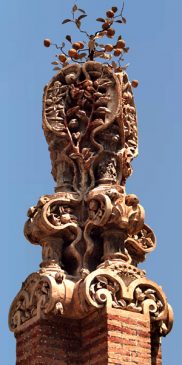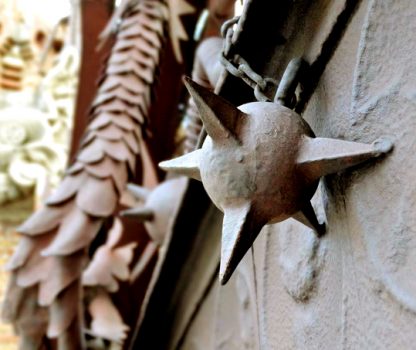The spectacular Dragon gate of Finca Güell is one of the best forging pieces designed by Gaudí. In addition to being the main entrance to the estate, it is an essential part of a symbolic program that materializes in architecture passages from the poem “L’Atlàntida”, by Jacint Verdaguer.
The priest and poet, born on May 17, 1845, was in charge of administering the donations of Antonio López, father-in-law of Eusebi Güell, and for a few years chaplain on the ships of his Transatlantic Company. Within his poetic work he honored his protector and patron, equating him to Hercules in the verses of the epic poem L’Atlàntida, which won the extraordinary prize in the Jocs Florals of 1877.
The work, based on a mythological story, relates Christopher Columbus with the vicissitudes of the greek hero, who, punished, had to carry out twelve colossal works. One of them was to get the golden apples, fruits of a tree that grew in the Garden of the Hesperides and that granted immortality. The tree was guarded by three maidens and the dragon Ladon.
Through a trick, Hercules managed to take away the fruits and a branch of the magnificent tree, which is identified by the greeks with the orange tree, an unusual and exotic tree that remains green all year round and bear fruit in winter. With that branch he will create a new Garden of the Hesperides. Meanwhile, Ladon was chained and converted into the constellation of the dragon as punishment for not having been able to fulfill his mission, and the maidens in a poplar, a willow and an elm.
Gaudí gave architectural form to this story when Güell commissioned him to carry out works on his 20-hectare estate located between Les Corts and Sarrià, in what was then the outskirts of Barcelona.1 Gaudí carried out various reforms on the house, redesigned the garden and built fountains, viewpoints, riding arena and a closing wall with three doors. There are numerous references to the poem L’Atlántida. Among the lush vegetation there are several specimens of poplars, willows and elms that symbolize the punished maidens.



The magnificent main entrance door is flanked by the porter house and the stable and interior horse riding, buildings whose oriental influence is typical of Gaudí’s first stage. These constructions incorporate various combined techniques: stone, exposed brick, catalán vault and ramed earth.
The spectacular 5 meter-wide gate stands out, made in 1885 in the Vallet and Piqué workshop, 2 which combines iron profiles, stamped plates, meshes and various metal elements. The lower part is a grid of profiles arranged diagonally joined by patterned squares with reliefs representing roses. This frame is closed by a smooth lower crossbar and an upper one that supports the dragon stamped with the same flowers as a decorative border.

Its anatomy is formed by curved profiles covered with iron sheets. The body develops sinuously until ending in a coiled tail, and the wings are of mesh. The head shows its open mouth with sharp teeth and its forked tongue threateningly extended. Equally spectacular are the legs with sharp claws. The composition is completed with chains that recreate those that, according to the myth, immobilize the animal. Old photos show that his eyes, today hollow, had crystals in the past.
The monster is said to have frightened passers-by.3 It is also frequently repeated that when the door was opened the dragon moved its front leg by means of a mechanism that is now out of operation. This was shown to be nothing more than a legend based on the fact that the door was long maintenance-free and that member’s fasteners had been loosened. Once the screws that held it were tightened, the movement stopped, but the story, which is undoubtedly attractive, did not.

The shape of the animal roughly follows the arrangement of the stars of three constellations in the boreal sky: the head, body and tongue, that of the Dragon, the leg that of Hercules, and the tail would be the Little Dipper. Several spheres with spikes distributed in the composition would represent stars, although not all coincide with the position of the stars.4
The dragon is oriented exactly to the north, where the constellations mentioned are located. It has been said that this allows see them just above the iron dragon on certain nights of the year, although the reservation must be made that the door dragon has its head to the east and its tail to the west, as opposed to the arrangement of the constellations.

The large 10-meter pillar that supports the gate is made of stone and exposed brick, crowned by orange trees depicted in reliefs on a large piece of artificial stone, and above it stands the Hesperides tree made of antimony with its branches, leaves and fruits. The composition incorporates a very elaborate initial “G” inscribed in another octagonal shaped artificial stone piece.

A pedestrian door on the left is another excellent example of Gaudí’s ability to achieve impressive results using inexpensive materials. In this case he composes a magnificent door with square, rectangular and round iron bars that includes the same “G”, in this case facing inward. The frame is made of the same materials as the pillar, with a lintel covered with precast pieces of mortar whose vegetable reliefs reproduce cotton plants, possibly in tribute to Joan Güell, Eusebi’s father, enriched in Cuba thanks to this cultivation.

The other two doors, to the south and east, remained outside the original property when the new urban layout that divided the farm was drawn up. The South door is made up of two symmetrical bodies on each side of the entrance built with exposed bricks and crowned with white and green tiles. Its wrought iron gate is preserved in the garden of the Gaudí Museum in Park Güell. This door is now surrounded by buildings of the University.
The East gate was demolished when the Faculty of Pharmacy was built in the 1950s and later rebuilt on a smaller scale in front of the building. It is made of bricks and consists of a lowered arch topped by battlements between two pillars that end in pinnacles. The battlements and pinnacles are lined with white and brown ceramics.

The South door in its current state and the reconstruction of the East door of the Finca Güell

Güell and Gaudí left another reference to the story of L’Atlàntida in the party wall of the Palau Güell with a large mural painting of Hercules on the way to the Garden of the Hesperides, commissioned to Aleix Clapés. This already disappeared image was visible from La Rambla.
Verdaguer and Gaudí were members of the Barcelona excursion associations and shared various activities such as events and visits to monuments.5 The architect had in his library copies of “L’Atlàntida” and “El Canigó”, the other masterpiece of Verdaguer, and highly valued the writer’s literary ability, as he once explained to the then young Joan Matamala.6
The door of the dragon was for 40 years the entrance of the Gaudí Chair of the Universitat Politècnica de Catalunya, in the old stables and the riding school between 1968 and 2008. There, under the direction of Dr. Joan Bassegoda Nonell, an important cataloging work, research and dissemination of Gaudí’s work.
BIBLIOGRAPHIC REFERENCES
1 Bassegoda Nonell, J. El jardín de las Hespérides, in Sarrià. La Vanguardia Española, 18 june, 1978.
2 El correo catalán. Barcelona. 18 may, 1885. P. 2.
3 Ràfols, J. F. Gaudí. Ed. Canosa. Barcelona. 1929. P. 48
4 Bassegoda Nonell, J. El gran Gaudí. Editorial Ausa. Sabadell 1989. P. 272.
5 Ibid. Pp. 173-174.
6 Matamala, J. Antoni Gaudí. Mi itinerario con el arquitecto. Ed. Claret. Barcelona.2006.

